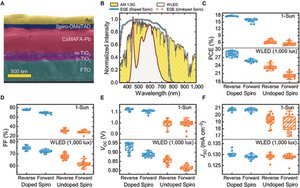Is Doping of Spiro-OMeTAD a Requirement for Efficient and Stable Perovskite Indoor Photovoltaics?
Sami Toikkonen, G. Krishnamurthy Grandhi, Shaoyang Wang, Bora Baydin, Basheer Al-Anesi, L. Krishnan Jagadamma, Paola Vivo.
Adv Devices Instrum.2024;5:0048.
The study investigates the necessity of doping Spiro-OMeTAD in lead halide perovskite (LHP) indoor photovoltaics (IPVs). It concludes that undoped Spiro-OMeTAD can achieve high efficiency and stability under low-light conditions, rivaling doped counterparts, suggesting that dopants may not be essential for effective IPV performance.
How Litos Lite was used
Litos Lite was utilized to perform J–V reverse and forward sweeps (scan rate 50 mV s−1), maximum power point (MPP) tracking, and stable power output (SPO) measurements on the prepared photovoltaic cells. These measurements were conducted under both simulated sunlight (AM 1.5G, 1-Sun, 100 mW cm−2) and indoor WLED illumination (5,000 lux, ≈1.60 mW cm−2) in N2 atmosphere. The indoor MPP tracking was performed either under continuous illumination or in 8-hour light–16-hour dark cycles .
How Paios was used
Transient photovoltage and transient photocurrent measurement were carried out with the all-in-one characterization platform, Paios.

